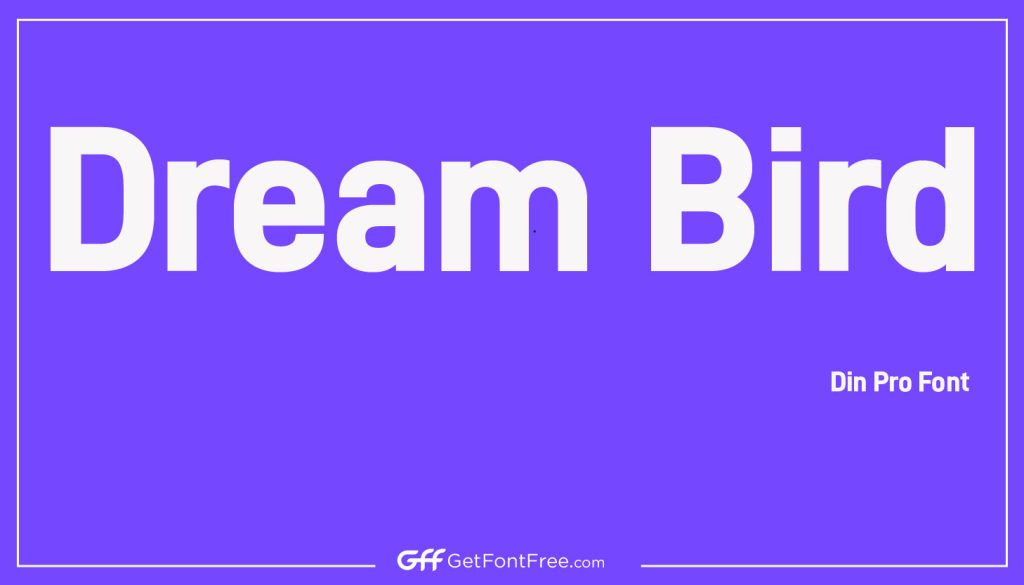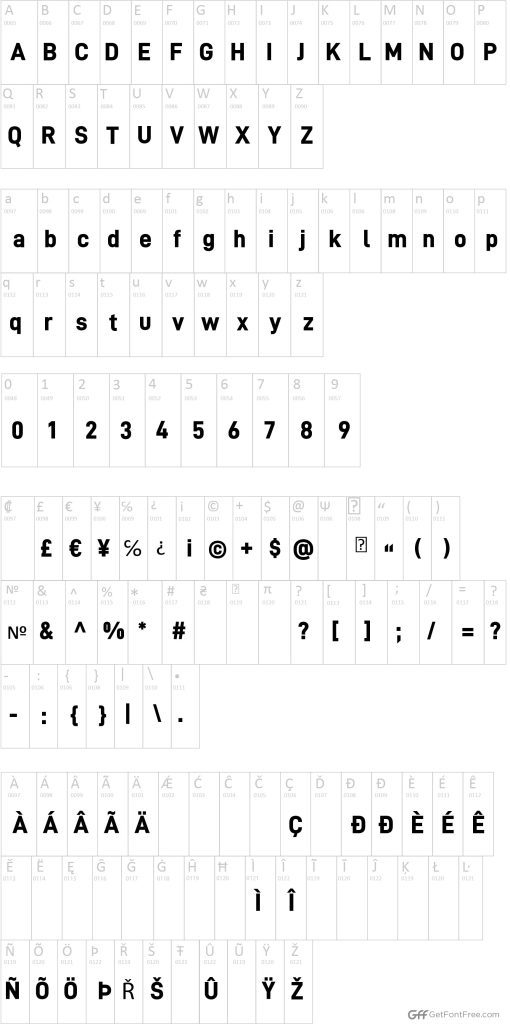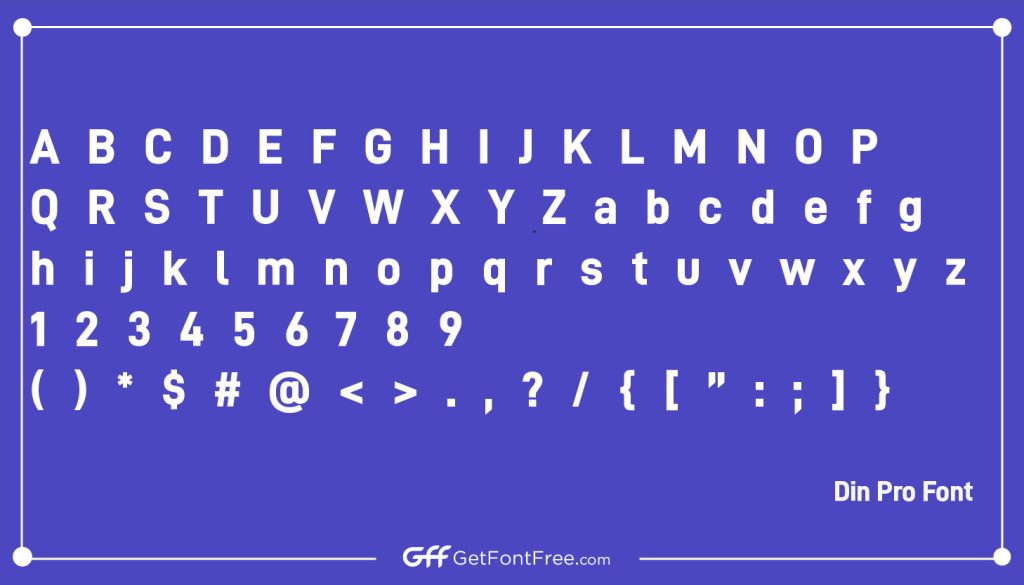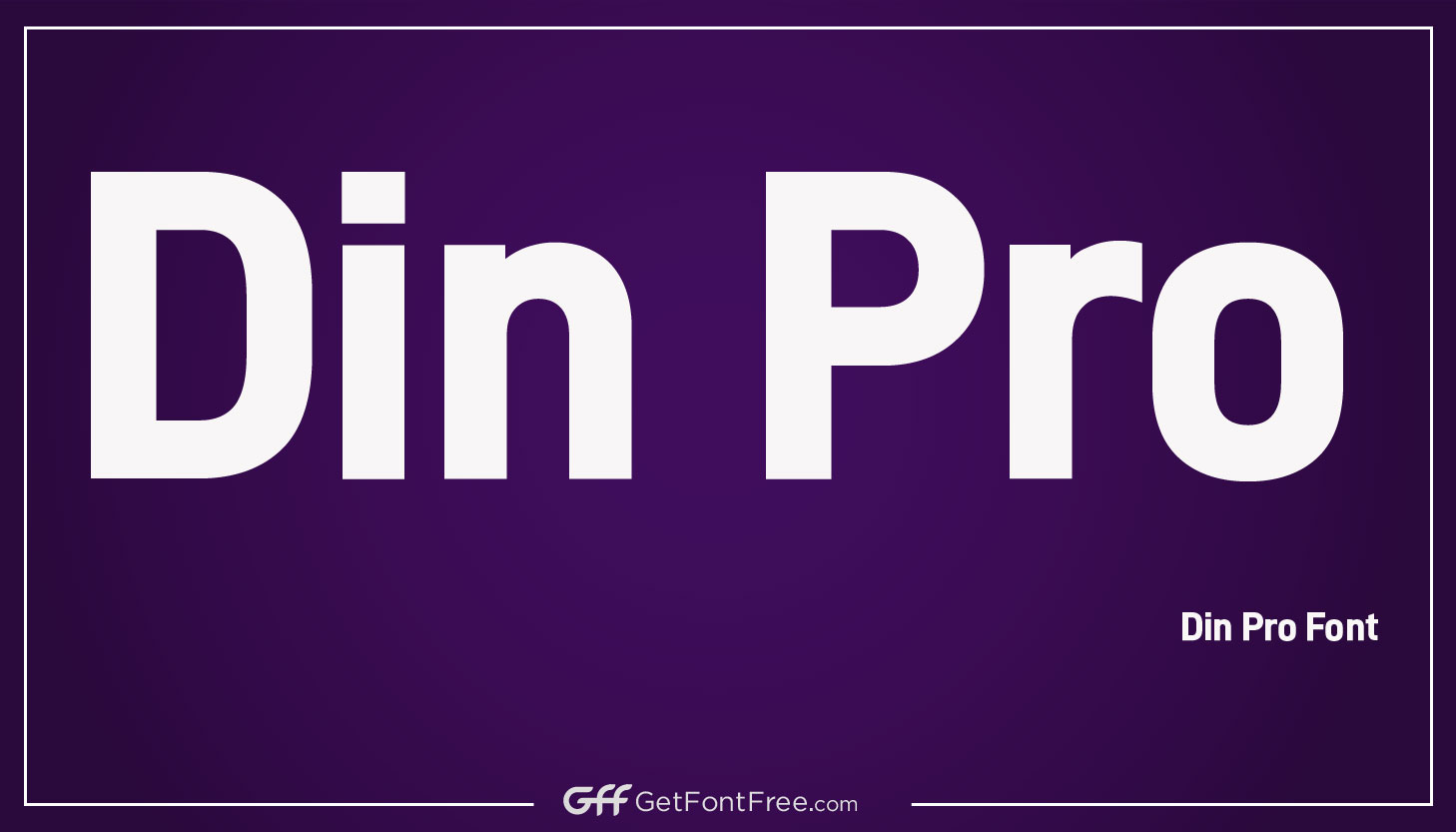DIN PRO FONT is a sans-serif typeface that is widely used for traffic, administrative, and technical applications. It was created by the German typeface designer Albert-Jan Pool in 1995 and is based on the DIN 1451 standard, which was established by the German Institute for Standardization (Deutsches Institut für Normung) in the 1930s for use on road signs and other technical documentation in Germany.
DIN is known for its clean, geometric design and its efficient use of space, which makes it a popular choice for technical drawings and diagrams as well as for digital interfaces such as websites and mobile apps. The typeface has a number of variations, including DIN Pro, which is a commercial version of the original DIN font that includes a wider range of characters and weights.

DIN Pro is a modernized version of the original font family and is having more weights, It is a complete font family that includes eight weights (from Thin to Black) with matching italics. The font family also includes an alternative version of the letter ‘a with a curved tail. This alternative version is known as “the DIN an alternate” and can be used in design projects where a more unique and playful touch is needed.
This font is widely used for industry and technical-related documents, the well-spaced letter forms, the unique DIN ‘a’ alternate, and the range of weights make it a versatile font for a wide range of design projects, from print to digital.
Din Pro Font information
Here is the information you requested in table form:
| Name | DIN Pro |
| Designer | Albert-Jan Pool |
| Foundry | ParaType |
| Style | Sans-serif |
| File Format | TTF, OTF |
| Date Released | 1995 |
| License | Commercial |
| Type | Display |
Reason to Use Din Pro Font
- Clean and Geometric Design: DIN Pro has a clean, geometric design that makes it easy to read and easy on the eyes, even in small sizes. This makes it a good choice for technical documents and diagrams, as well as digital interfaces like websites and mobile apps.
- Space-efficient: The typeface is designed to be space-efficient, meaning that it uses less horizontal space than many other typefaces. This makes it a good choice for layouts where space is limited, such as in navigation menus or in charts and diagrams.
- Versatile: The DIN Pro font family includes a wide range of weights and styles, from Thin to Black with matching italics. This makes it a versatile choice for a wide range of design projects, from print to digital.
- Recognizable: DIN Pro is based on the DIN 1451 standard, which was established for use on road signs and other technical documentation in Germany. DIN is widely used and recognized, it can be a great choice for designs where legibility, technicality, and professionalism are key.
- The DIN ‘a’ alternate: The font family also includes an alternative version of the letter ‘a’ with a curved tail. This alternative version is known as “the DIN an alternate” and can be used in design projects where a more unique and playful touch is needed, without losing the technical and professional tone of the font.
Din Pro Font Family (Includes Total of 8 Typefaces)
The DIN Pro font family includes a total of 8 different typefaces:
- DIN Pro Thin
- DIN Pro Thin Italic
- DIN Pro Light
- DIN Pro Light Italic
- DIN Pro Regular
- DIN Pro Italic
- DIN Pro Medium
- DIN Pro Medium Italic
Character Map

Alternatives of Din Pro Font
There are a number of typefaces that share similarities with DIN Pro and could be used as alternatives. Here are a few examples:
- Futura: This is a classic geometric sans-serif typeface that was designed by Paul Renner in 1927. It has a similar clean, geometric design to DIN Pro and is also space-efficient.
- Avenir: This typeface was designed by Adrian Frutiger in 1988. It also has a geometric design with similar clean lines and efficient use of space as DIN Pro. Avenir also includes a wide range of weights and styles.
- Arial: Arial is a typeface that was designed to be similar to Helvetica. It has a clean, modern design and includes a wide range of weights and styles. Arial is widely used for digital interfaces, so it could be a good choice for web and mobile design.
- Lato: designed in 2010 by Łukasz Dziedzic. Lato is a geometric sans-serif typeface family that has a similar clean and simple design, it’s available in a wide range of styles, and weights, and it’s free to use under an Open font license.
- Roboto: designed in 2011 by Christian Robertson, Roboto is a geometric sans-serif typeface family that is similar to DIN Pro in terms of its clean and simple design. it’s available in a wide range of styles, and weights and it’s also free to use under Apache 2.0 license.
License Information
This license will typically specify certain usage restrictions, such as the number of computers or users that can use the font and the types of documents or projects it can be used in. Some licenses allow for web usage (embedding the font in a website using @font-face), while others do not. It’s always good to check the specific terms of the license before using the font, as usage terms can vary based on the foundry or vendor.
In addition to purchasing a license, you’ll need to make sure that you are using the most recent version of the font and that you are using it in compliance with the license agreement. This will ensure that you are able to use the font without any legal issues.
Supported Language
However, the specific language support and character sets might vary depending on the version of DIN Pro font you are using and the foundry that you are purchasing it from. Some versions might include support for additional languages, such as Greek or Cyrillic, while others may not.

You should check with the foundry that you are purchasing the font from to confirm the specific language support and character sets that are included.
FAQs
What is DIN Pro font?
DIN Pro is a commercial version of the original DIN font that was created by German typeface designer Albert-Jan Pool in 1995. It is based on the DIN 1451 standard and it’s widely used for traffic, administrative, and technical applications. It is known for its clean, geometric design and efficient use of space.
Who created the DIN Pro font?
DIN Pro font was created by Albert-Jan Pool a German typeface designer, who based it on the DIN 1451 standard.
What are the styles included in the DIN Pro font family? The DIN Pro font family includes a total of 8 different typefaces: DIN Pro Thin, DIN Pro Thin Italic, DIN Pro Light, DIN Pro Light Italic, DIN Pro Regular, DIN Pro Italic, DIN Pro Medium, DIN Pro Medium Italic
Is DIN Pro a free font?
No, DIN Pro is a commercial font and it requires a purchased license to be used. You will typically need to purchase a license from the font foundry that distributes it.
What are the similarities between DIN Pro and other fonts?
DIN Pro shares similarities with other geometric sans-serif typefaces like Futura, Avenir, Arial, Lato, and Roboto. They all have a clean and simple design, and efficient use of space, but each has its own unique characteristics and the best alternative will depend on the specific requirements of your project.
Is DIN Pro font good for digital interfaces?
Yes, DIN Pro font has a clean and simple design which makes it easy to read and easy on the eyes, even at small sizes. this makes it a good choice for digital interfaces such as websites and mobile apps.
What is the usage restriction of DIN Pro font?
The license agreement that you purchase will typically specify certain usage restrictions, such as the number of computers or users that can use the font, the types of documents or projects it can be used in, and whether it can be used for web usage (embedding the font in a website using @font-face). It’s always good to check the specific terms of the license before using the font, as usage terms can vary based on the foundry or vendor.

